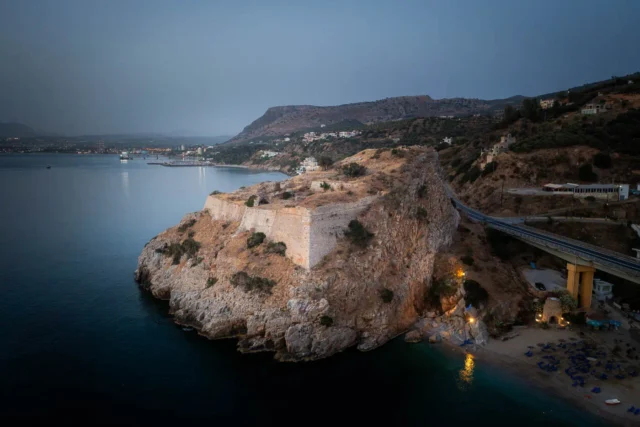

The Bethlehem Bastion and Gate are integral parts of the historic Venetian walls that encircle Heraklion, Crete. Built in the 16th century, these fortifications played a crucial role in the city’s defense, particularly during the lengthy Siege of Candia.
The Fortifications of Heraklion
Early Walls
Heraklion’s earliest walls date back to the Byzantine era. In 824, Arab forces captured the city and built walls of unbaked bricks, surrounding the city with a defensive trench. The city, known as Rabdh al-Khandaq (Trench Castle), became the capital of the Emirate of Crete.
In 961, the Byzantines, led by Nikephoros II Phokas, recaptured Heraklion. They destroyed the Arab fortifications and built a new fort named “Rokka.” As the settlement grew, the Byzantines constructed new walls on the site of the previous Arab walls. Remains of these Byzantine walls can still be found near Heraklion’s harbor.
Venetian Walls
In the early 13th century, the Republic of Venice took control of Crete. They initially used the existing Byzantine walls, making modifications as needed. However, the fall of Constantinople in 1453 and the rise of the Ottoman Empire prompted the Venetians to build a new, more formidable fortification system.
Construction of the new walls began in 1462. The walls were designed by prominent military architects Michele Sanmicheli and Giulio Savorgnan. They took over a century to complete, and various outworks were added over the years to further strengthen the fortifications.
Ottoman Rule and Modernization
The fifth Ottoman-Venetian War (1645-1669) saw the Ottoman navy arrive off Crete on June 23, 1645. While Canea and the Fortezza of Rethymno fell to the Ottomans, the Venetian garrison in Candia (Heraklion) held out for 21 years, making the Siege of Candia the second-longest siege in history. The city surrendered in 1669, and the Venetians were allowed to leave peacefully, sparing the city from being sacked.
After the Ottoman conquest, the fortifications were repaired and maintained. The bastions were given Turkish names; for example, Martinengo Bastion became Giouksek Tabia. The Ottomans also built a small fort known as Little Koules near the Rocca al Mare (now known as the Koules Fortress). This was later demolished in 1936 during the city’s modernization.
The walls sustained damage from German aerial bombardment during World War II, but the damage was repaired. After the war, some outworks were demolished to accommodate modern buildings. There were even suggestions to demolish the entire city walls, but this never happened. Today, the walls remain largely intact, standing as some of the best-preserved Venetian fortifications in Europe.
Bethlehem Bastion
The Bethlehem Bastion is located on the western side of the Heraklion Walls, between the Martinengo and Pantokrator Bastions. It was named after a small church dedicated to the Nativity of Christ that was located outside the walls. The bastion was designed to protect the city from attacks originating from the west.
During the Siege of Candia, the Bethlehem Bastion, along with the rest of the western fortifications, faced constant attacks from the Ottomans. The Venetians, under the leadership of General Morosini, made significant efforts to improve the bastion’s defenses. They strengthened the walls, added a ravelin, and constructed additional bastions to reinforce the area.
Bethlehem Gate
The Bethlehem Gate, a military gate, is situated beneath the Bethlehem Bastion. It led to the northern low square of the bastion, where cannons were positioned to protect the Pantokrator Bastion. The gate currently serves as a venue for cultural events and houses a summer municipal cinema.
Summer Cinema
The Municipal Summer Cinema, established in 2007, is located in the southeastern low square of the Bethlehem Bastion. It offers a unique setting for film screenings, with the historic walls providing a dramatic backdrop. The cinema shows a variety of films, including new releases, short films, children’s movies, classic films, and special thematic programs.
“El Greco – Return to the Homeland” Exhibition
In recent years, the Bethlehem Gate has also hosted the exhibition “El Greco – Return to the Homeland.” The exhibition features costumes and props used in the film “El Greco” by Yannis Smaragdis, dedicated to the great Cretan painter Domenikos Theotokopoulos, known as El Greco. It also includes recreated works and objects related to El Greco’s life and art.
“Kommeno Benteni”
In the 20th century, a section of the walls near the Bethlehem Gate was cut to create a passage connecting the new city with the old town. This area became known as “Kommeno Benteni,” meaning “cut wall.”
Fortifications: Key Points
- Construction Period: 16th century
- Location: Western side of the Heraklion Walls
- Historical Significance: Defensive bastion, venue for cultural events, houses a summer cinema
- Current Status: Well-preserved, open to the public
References
- Gerola, G. (1905). Monumenti Veneti nell’isola di Creta. Venice: Istituto Veneto di Scienze, Lettere ed Arti.
- Sythiakaki, V., Kanaki, E., & Bilmezi, C. (2015). Older Fortifications of Heraklion: A Different Approach Based on Recent Excavation Data. In Archaeological Work in Crete 3 (pp. 395-410). Rethymno: University of Crete.
- Gigourtakis, N. M. (Ed.). (2004). Heraklion and its Area: A Journey Through Time. Heraklion: Center for Cretan Literature.



































There are no comments yet.